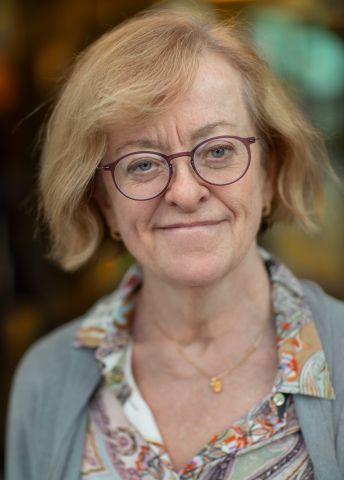
Lena Claesson-Welsh
Professor of Medical Biochemistry
Wallenberg Scholar
Institution:
Uppsala University
Research field:
Mechanisms for blood vessel growth and blood vessel leakage

Wallenberg Scholar
Institution:
Uppsala University
Research field:
Mechanisms for blood vessel growth and blood vessel leakage
Over the past ten years Claesson-Welsh has concentrated on blood vessel leakage, particularly from the blood vessels that form in tumors. These blood vessels do not function very well; they show a low rate of blood flow and extensive leakage into surrounding tissue.
“We have learnt to study leakage both in section from tissues, and in living tissue. Leakage in living tissue is particularly interesting – would you like to see?” asks Claesson-Welsh.
She opens up her laptop and retrieves a film showing a close-up of blood vessels in a mouse’s ear. When she starts the film, nothing happens at first, but a dramatic change occurs when a protein called VEGF is injected into the skin. Parts of the vessel immediately begin to leak, and fluid gushes out.
“We’ve discovered something unique about the leaking parts. When we stop the experiment, the blood vessel closes up again. If we do it again an hour later, it leaks again – in exactly the same places as before.”
Leakage not only causes patients discomfort; it makes it difficult to reach the tumor with drugs. Tumor cells can also find their way into the blood stream and spread to seed metastases more rapidly.
Growth of new blood vessels is regulated by the VEGF protein, which affects the cells lining the interior surface of the blood vessels: endothelial cells. These cells are able to act as a sluice for movement of nutrients and fluid to and from surrounding tissue. But when cancer strikes, the sluice remains open, allowing fluid to pour out of the blood vessel.
The research team has mapped the process from the point at which the VEGF molecule binds to the cell surface to the moment that the endothelial cells let go of each other. Now the aim is to identify all molecules involved in the chain.
“When we’ve done that, we will have identified targets for new drugs. And we’ll then be able to set up models to try to block one of these stages.”
They will be using animal models representing each link in the chain. And they have found several potential targets for drugs.
“But it’s been incredibly difficult – so difficult that I’m amazed there actually are any drugs that work.”
The extension of Claesson-Welsh’s Scholar grant will now enable her to aim higher.
“The fantastic thing about the Scholar grant is that it enables me to take on really difficult challenges. I truly appreciate the opportunity that this funding has given me.”
“One of our goals is to find a biomarker for leakage. We also want to see whether there are synergies between our way of breaking the chain for VEGF and various immunotherapies for cancer,” she says.
VEGF also plays a part in several eye diseases. Diabetes is one example, where microscopic blood vessels in the retina change and thicken. Another is macular degeneration, where there is growth in blood vessels under the macula lutea. Both of these diseases are age-related, and are becoming more common as we live longer.
For the past ten years treatments have been available that can completely block VEGF in the eye. This reduces blood vessel leakage, but eventually kills the blood vessels. The treatment is therefore only a short-term solution.
“Patients see better to start with, which supports the hypothesis that vessel leakage and swelling are factors in the disease. But after a time the patient’s eyesight deteriorates beyond its pre-treatment state. This is because there are other cell types in the eye – neurons in the retina – that need VEGF to work. These factors combine to cause worsening eyesight,” Claesson-Welsh explains.
The treatments are also unpleasant for patients, involving injections into the eyeball to arrest VEGF. It would be better if it were possible here, too, to break the chain between VEGF and endothelial cell growth. She describes blocking VEGF completely as “using a sledgehammer to crack a walnut”.
Claesson-Welsh likes to use metaphors to explain her work. She thinks it is important to be able to explain her research to a fairly uninitiated public. She recently gave a lecture arranged by Folkuniversitet – an adult education association – at a movie theater in Stockholm.
“It was almost a full house. It gives me a real boost when so many people come to listen to me. It’s essential that you find the right words and figures of speech so people can understand the work you’re doing.”
Also, her research is now so specialized that it is often necessary to simplify things even when explaining it to other scientists. But the challenge this poses spurs her on.
“It can give you a better insight into your own work. You’re forced to skip the details and present the bigger picture.”
Being voted Cancer Researcher of the Year 2017 entailed giving lectures and taking part in events over the year.
“The award gave me legitimacy as a cancer researcher. I also became someone people recognized when I travelled to give lectures and attend events. This is the first time I’ve had such a high profile in my professional role.”
During the year she had many rewarding meetings, but also faced difficult questions, often from cancer sufferers themselves.
“Those questions improved my ability to see cancer from the patient’s perspective, and gave me a better understanding of the way the disease progresses.”
The goal as a cancer researcher is to enable patients to lead full lives by transforming cancer into a chronic disease.
Text Magnus Trogen Pahlén
Translation Maxwell Arding
Photo Magnus Bergström